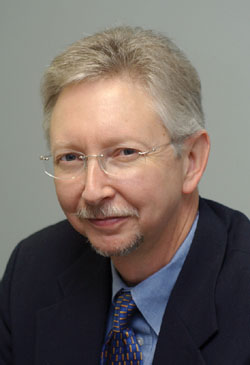
Frank E. Harrell Jr.
New Department of Biostatistics established, Harrell to chair
Frank E. Harrell Jr., Ph.D., has been named the chair of the new Department of Biostatistics at Vanderbilt University Medical Center. Harrell, who was previously professor of Biostatistics at the University of Virginia, will assume the position pending Board of Trust approval in November.
Prior to his stint at UVA, Harrell, who has a Ph.D. from the University of North Carolina, Chapel Hill, spent more than 17 years in the Duke Clinical Research Institute. There he worked on clinical trials and on the development of the Duke Cardiovascular Disease Databank, one of the largest prospective cohort studies of patients with coronary heart disease. Models were developed in the study for estimating how long patients with cardiovascular disease will live, and how various therapies affect the chances of the patients’ survival.
Harrell began a new division of Biostatistics and Epidemiology at the University of Virginia in 1996. He has also served on the FDA Cardio-Renal Advisory Committee, as an FDA Statistical Consultant in Biometrics since 1992, and has been co-editor of Health Services and Outcomes Research Methodology since 1999.
Biostatistics is a basic science of biomedical research. The involvement of biostatisticians throughout the grant proposal process significantly increases the likelihood of research funding, Harrell said.
“This position is the opportunity of a lifetime for someone whose career is devoted to research in and the practice and teaching of biostatistics in academic medicine,” Harrell said. “There is now the opportunity to develop biostatistics into both a major resource for biomedical research at Vanderbilt and into a strong research unit in its own right. With the explosion of NIH grant funding at VUMC, it’s a perfect time for biostatistics to be growing at Vanderbilt. The success in clinical research and health services research at the medical center is stunning.”
Harrell plans for the department to add a significant number of new faculty. The division of Biostatistics, which has been part of the Department of Preventive Medicine, currently has eight on staff. Most research institutions with comparable NIH dollars have two to three times that many, he said.
“The leadership of the School of Medicine has made it clear that Vanderbilt desires to have a well-supported and world-class biostatistics department that provides excellent research infrastructure support, and that has its own strong research and teaching program,” he said.
The search for a department chair was led by Dr. Robert S. Dittus, Joe and Morris Werthan Professor of Investigative Medicine. Of the 125 medical schools in the United States, approximately 25 percent have either a freestanding Department of Biostatistics or a Division of Biostatistics, most often within a School of Public Health.
Dr. Steven G. Gabbe, dean of the Vanderbilt University School of Medicine, said Vanderbilt is fortunate to have a biostatistician with Harrell’s qualifications to lead the new department.
“The creation of a Department of Biostatistics enables the University and the School of Medicine to advance its position as a national leader in both clinical and basic research, provide educational programs to train the next generation of researchers and biostatisticians, and strengthen an essential component of our efforts to support bench-to-bedside or translational research,” Gabbe said. “Dr. Harrell is a nationally and internationally recognized leader in biostatistics. We look forward to the excitement and expertise he will bring to this new department.”
Harrell said he has several goals in mind for the new department.
“One of the most important goals of the new department is to develop methods for sustaining the department's ability to respond to and generate new biomedical research opportunities throughout the school in an era in which there is a shortage of statistical scientists,” he said. “We want to develop collaborative relationships with other departments, and not just provide technical services. We want to be fully integrated into the biomedical research fabric at Vanderbilt so as to optimally educate biomedical researchers about study and experimental design and measurement issues and data analysis, and to learn from biomedical researchers so as to better understand their research, which will lead to more effective collaboration.”
Harrell said he also wants to thoroughly integrate biostatistics into biomedical research.
“We want to use best biostatistical methods as experimental designs to benefit the quality, efficiency and ethical conduct of biomedical research. One way is to use modern statistical methods as efficiently as biostatisticians at other medical centers used older technology.”













